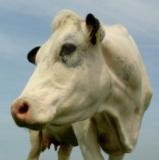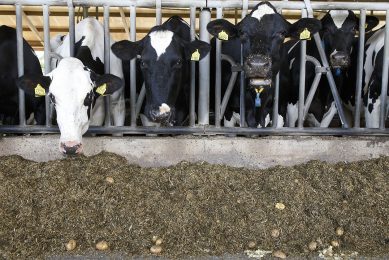Factors that influence FC in dairy cattle

The parameter feed conversion (FC) in the dairy sector hard to interpret. Researchers from Wageningen University and Research Centre therefore studied the factors that influence feed conversion and feed-bound costs in dairy practices.
ration composition, differences among the animals and there is a significant
temporal variation in feed efficiency. This makes the parameter feed conversion
in the dairy sector hard to interpret. In the intensive livestock production, a
lower feed conversion generally leads to a better economic performance. In the
dairy sector this relation is considerably less apparent; a low feed conversion
does not necessarily lead to a better result than a high one.
Relation
with milk yield
According to the study, the feed conversion should be
considered in close relation to the milk yield. In general, a high milk
production goes with a low feed conversion and vice versa. In relation to this:
a high milk production usually involves a high feed intake and all the same a
low feed conversion.
Because milk production plays a dominant role in the
parameters feed conversion and gross return minus feed costs, these parameters
rather mirror the production level than that what they are meant for, namely the
(economic) utilisation of feed. The farmer’s ambition should lie in improving
the quality and utilisation of roughage with a lower feed conversion as a
result.
Economics
The researchers did not find a clear relation
with feed conversion and the dairy farmer’s income. There was a relation between
the costs of the entire feed process. These involve not only the feed costs, but
also all costs that have to do with acquiring and supplying the feed. The study
showed that the costs of home-produced roughage are rather high, the net costs
of which are often higher than its market value.
Feed conversion is an
optimum characteristic, economically and technically speaking. A very low feed
conversion can lead to a reduction in body condition of dairy cattle with
possibly corresponding health and fertility problems, while a high feed
conversion goes together with too high a cost. Also nutrient utilisation is
important (consider, for example, nitrogen).
Dynamic
approach
The Animal Sciences Group from Wageningen UR recommends a
“dynamic” approach in monitoring and controlling feed efficiency and production.
With this approach, the question: “what is the response of dairy cattle to
change in feed?” continuously applies.
When the farmer knows the effect of
the feeding measures or when it can be estimated in advance, he can base his
decisions on this, aiming at a farm performance as good as possible. The
objective for a dynamic linear feed model is maximising the gross return minus
feed costs. This economic parameter depends on, among other things, the feed
utilisation. There is much variation in feed utilisation, due to differences in
efficiency among the animals, but also within the animals, due to temporal
variation. The dynamic linear feed model supports operational management and can
be automated and implemented in dairy farm management systems well. The
“dynamic” approach is currently being developed and tested by the Animal
Sciences Group and is very promising for practical application.
The report “Feed conversion in dairy
cattle” (in Dutch) is published by Animal Sciences Group
, Lelystad,
the Netherlands. Email: info.po.asg@wur.nl
External link:
The effect of dairy breeds on feed conversion efficiency
To subscribe to the free
AllAboutFeed newsletter click here.











